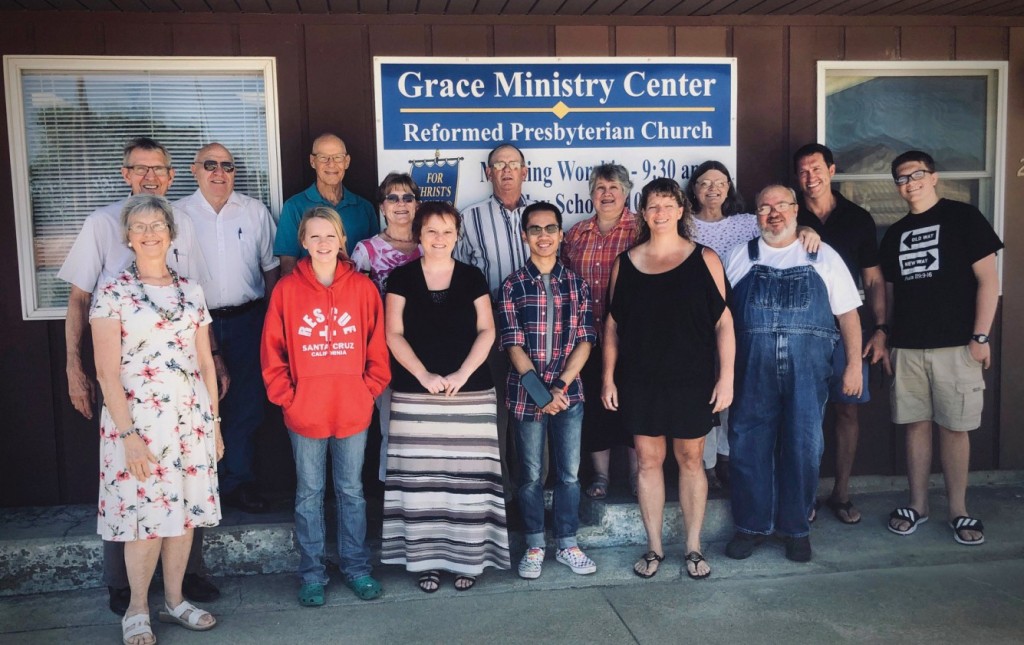You have free articles remaining this month.
Subscribe to the RP Witness for full access to new articles and the complete archives.
Presbytery: Midwest
Organization: 1855
Membership: 14 communicant; 4 baptized
Pastor: Jack Baumgardner
Website: https://clarindarpchurch.wordpress.com/
The first three Covenanter families from eastern Iowa arrived in 1854, picking out homesteads and settling several miles south of what is now Clarinda in southwestern Iowa. This land had previously been occupied by the Sac and Fox Indians, and native homes and burial sites were still common. Other families soon followed, and the congregation was organized in 1855 with 34 members. After initially meeting in homes for worship, in 1856 the congregation built a log cabin that served as a church and a school.
In 1857, land on a beautiful hill site near the center of the farming colony was bought for the church and cemetery: a one-and-a-half-acre parcel for 25 cents and an adjoining acre and a half for two dollars. Four more church buildings were successively built, the last being a large brick structure in 1918 at a cost of $20,000. To help meet construction and operating expenses, seating was often purchased, with the oldest member given first choice of seat or pew location. The congregation purchased an additional acre and a half for a parsonage.
The cemetery has the earthly remains of many saints, including military veterans of three wars. During the Civil War, 26 young men from the congregation went off to fight for the Union. Being so near the Missouri border, guns were carried to church. During one worship service, word came that nearby Bedford was being threatened by invaders. Rev. McKee announced from the pulpit that men should take their guns and proceed to Bedford, while the women went home to prepare a wagonload of supplies. The cemetery also contains the remains of several black saints, who reportedly had been denied permission to be buried in the city cemetery.
In the early days, it was a long ride over dirt roads for many to go to church in wagons and buggies. The service began at 10 o’clock with a psalm explanation, and at eleven there was an hour-long sermon. A short intermission followed while people went to their wagons and buggies for lunch. Then came an hour’s lecture, and then Sabbath school. In the evening, various fellowship groups met, followed by evening worship. (In 1900, Clarinda reported a communicant membership of 180, a Sabbath school with 210 scholars, and 80 young people.)
The church building served for more than corporate worship, including gatherings such as fellowship suppers, summer vacation Bible school, Women’s Christian Temperance Union, Christian Endeavor Society, and Ladies Missionary Society. For children the large lawn had swings, a pivoting merry-go-round, and a volleyball court, while the church basement had ping pong and shuffleboard.
Through the years the congregation has had 16 ministers. During her early years, the congregation was instrumental in sending out families to help start other works, such as Sterling, Denison, Long Branch, Wahoo, Superior, and Winchester. Many Covenanter ministers and missionaries with names such as Caskey, Edgar, McMillan, and Carson have roots at Clarinda. In the late 1800s, an effort was made to donate 14 acres plus a building in Clarinda to the RPCNA for the purpose of establishing a western college site, but the proposal to Synod failed to garner enough support.
With the demographic change from the family farm toward large-scale corporate farming and the resultant loss of the rural population, along with the high cost of heating a large building, the congregation decided about five years ago to move into the city of Clarinda for corporate meetings. We now rent a building very suitable for our needs that is located one block from the courthouse. At the beginning of the COVID-19 pandemic, we held “Zoom church,” but we are presently using the building again with social distancing. Members continue to minister to the community in many different ways, including farming and other local industry, counseling, teaching, and various social groups.
Pray that members and adherents would remember that we are both saved and kept by grace; discern and faithfully use our individual gifts of the Spirit; be free of performance anxiety, while letting our light shine in such a way that the world gives glory to the Father; learn to see ourselves as God sees us: redeemed, righteous, and holy; and, come what may, remain confident that our spirits are fused together in union with Christ, knowing that “as He is, so are we in this world” (1 John 4:17).
